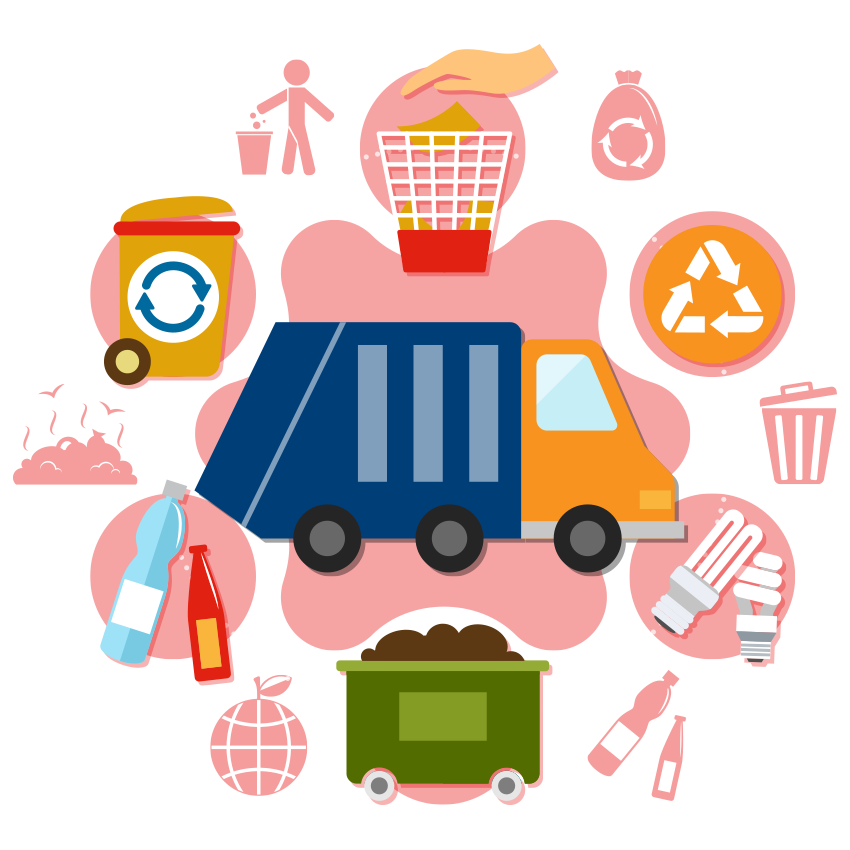



Waste is everything that is no longer needed. Waste that is not going to be recycled or reused but rather left in a landfill is called trash. In its essence, trash is a byproduct of lack of proper waste handling and generally bad behavior. Waste is an energy source which, when used correctly, won’t turn into trash if handled correctly and mindfully. Evolution of technology allowed us to reuse almost all types and sizes of waste, however it needs to be dealt with in order to be recycled. One of the key aspects of recycling is waste separation for every waste type. If different types of waste are placed together, they become trash. In developed countries ⅓ of waste produced in a typical household is separated. Waste separation creates added resources and saves energy and natural resources as well as decreases amounts of waste on landfills. It is important to know that each kilo of waste we recycle creates a better environment and protects people’s health.
Household waste is, as the name suggests, waste created in households, schools and service industries. Those types of waste are usually taken away as a part of a city maintenance. Industrial waste is created as a byproduct of production processes, schools/hospitals as well as service industries. However, this type of waste is different in its composition and size than household waste. That being said, all waste can be dangerous waste - if it includes dangerous substances that could be toxic or lethal to one’s health. Safe waste is waste that doesn’t have any components that could be poisonous. Inert waste is safe waste that doesn’t change biologically or chemically over time, it can’t be diluted, it doesn’t burn or react in any way nor is it biodegradable.

There is a saying that goes “Waste is not trash”. We can ask ourselves one important question: “What is trash and how do we create it?”. Simply put, trash is a byproduct of people’s improper waste handling as well as a mix of unseparated, irresponsibly thrown away reusable materials. Waste is a key issue of the modern civilization and an unavoidable reaction to the modern way of living. We should never throw garbage into nature as by doing so we endanger human and animal health and the wellbeing of an ecosystem as well as save money that needs to be used to clean it all up.
Organic kitchen waste are fruit and vegetable leftovers, coffee and tea leftovers, pieces of bread, wilted flowers, dirt,...
Things such as napkins, tissues, smaller non colored papers, ashes, egg cartons, egg shells...
Grass, leaves and bushes, leftovers from gardening, fruits, hay, saw dust, trees,...
Rainfall waters are considered waste waters in a broad sense of the term. Their chemical content changes depending on the air pollution - acid rain. Also, they can appear in agricultural places as a result of pesticide use and on traffic areas due to exhaust gases. Within this group are leftover waters from city and road cleanup.
Waste waters that are made in technological processes as well as a byproduct of energy production. Their contents depend on the industry that made them.
City waste waters are household waste waters.
Thrown out paper can make up to ⅓ of your average trash bin, however it shouldn’t end up there. By recycling paper, we save forests, energy, decrease air and water pollution. Paper can be recycled up to 7 times. Paper is disposed into recycling bins, however this is not the place for indigo paper, carbon paper, photographs, diapers etc.
To produce 1t od mid-quality paper you need to cut down 2 trees and use up to 240 000 l of water and 4700 kWh of electricity. To produce the same amount of recycled paper you need no trees, 180l of water and 2750 kWh of electricity.
This is a kitchen and garden waste that makes up to ⅓ of household waste and it can be reused to make compost. High quality compost can be a great replacement for industrial fertilizers.
Glass is a valuable raw material. If we collect thrown out glass, we can save energy and resources. Moreover, glass can be recycled up to 40 times. Glass is recycled in canisters, however this is not the place to put window glass, glass wool, light bulbs, porcelain, ceramic etc. This type of glass waste needs to be deposited at recycling yards. Energy that is saved by glass recycling is enough for a 100 W lightbulb to light up for 4 hours.
Plastic waste and cans make up more than 30% of a typical household waste. By recycling plastic, we save resources, decrease air pollution and save energy. Plastic packaging (PVC bags, foils, yoghurt cups, cleaning supplies bottles...) and cans are deposited in recycling bins and/or recycling yards.
To produce 1 kg of PET objects we need 1.9 kg of oil! Can production requires 3 times greater energy use, 5 times greater greenhouse gas emissions and roughly 10 times more waste than production of glass bottles
Metal objects can be recycled multiple times. Iron is cast and reused in new molds, therefore making new objects. To produce a new aluminum out of recycled materials, you will use up to 95% less energy than when producing it from non-recycled material. Recycling and collecting old material is energy efficient, environmentally friendly as well as economically beneficial.